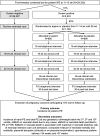Study protocol for the randomised controlled trial: combined multimarker screening and randomised patient treatment with ASpirin for evidence-based PREeclampsia prevention (ASPRE)
- PMID: 27354081
- PMCID: PMC4932292
- DOI: 10.1136/bmjopen-2016-011801
Study protocol for the randomised controlled trial: combined multimarker screening and randomised patient treatment with ASpirin for evidence-based PREeclampsia prevention (ASPRE)
Abstract
Introduction: Pre-eclampsia (PE) affects 2-3% of all pregnancies and is a major cause of maternal and perinatal morbidity and mortality. Prophylactic use of low-dose aspirin in women at risk for PE may substantially reduce the prevalence of the disease. Effective screening for PE requiring delivery before 37 weeks (preterm PE) can be provided by a combination of maternal factors, uterine artery Doppler, mean arterial pressure, maternal serum pregnancy-associated plasma protein A and placental growth factor at 11-13 weeks' gestation, with a detection rate of 75% at a false-positive rate of 10%. We present a protocol (V.6, date 25 January 2016) for the ASpirin for evidence-based PREeclampsia prevention (ASPRE) trial, which is a double-blinded, placebo-controlled, randomised controlled trial (RCT) that uses an effective PE screening programme to determine whether low-dose aspirin given to women from 11 to 13 weeks' gestation will reduce the incidence of preterm PE.
Methods and analysis: All eligible women attending for their first trimester scan will be invited to participate in the screening study for preterm PE. Those found to be at high risk of developing preterm PE will be invited to participate in the RCT. Further scans will be conducted for assessment of fetal growth and biomarkers. Pregnancy and neonatal outcomes will be collected and analysed. The first enrolment for the pilot study was in April 2014. As of April 2016, 26 670 women have been screened and 1760 recruited to the RCT. The study is registered on the International Standard Randomised Controlled Trial Number (ISRCTN) registry.
Trial registration number: ISRCTN13633058.
Published by the BMJ Publishing Group Limited. For permission to use (where not already granted under a licence) please go to http://www.bmj.com/company/products-services/rights-and-licensing/
Figures

References
Publication types
MeSH terms
Substances
Associated data
LinkOut - more resources
Full Text Sources
Other Literature Sources
Medical
Research Materials
Miscellaneous
